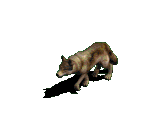Busta-yote--here's a diagram of the jaws of a coyote posted by Az Will on another board quite some time ago. I copied the picture and the text and am placing it below. You'd better copy it to your hard drive because I have this stored on PhotoPoint and I don't think I will be paying them $9.95 or $19.95 or anything else to store my pictures on their site. I think they have set April 30 as the deadline to pay up or get out.
Aging Coyotes (Taken from a posting by AZWill on Shade Tree Hunting Forum, 3/6/2000)
In the field, coyotes are normally aged in four categories or classes: (1) Pups; (2) Yearlings; (3) Mature; (4) Old.
At six months the pups normally have their permanent teeth and weigh between 12 and 16 pounds. Young coyotes retain a juvenile face until about eight months old.
At one year coyotes are fully-grown, seldom have much body fat, and their canine and incisor teeth are white and sharp showing no wear.
The above figure represents average tooth wear in a coyote, by years, at mid-winter.
1 yr. – Incisors all rounded; no wear facets; canines sharp, incomplete.
2 yr. – Incisors inner cusp blunted; distinct wear facet; notch distinct; incisor (1) slightly blunted; canines complete.
3 yr. – Incisor flat, notch barely visible; incisor (1) almost square, inner notch distinct, incisor (2) inner cusp half gone; other incisors showing some blunting.
4 yr. – Incisor flat; dentine showing, notch gone; incisor (2) almost flat, incisor (1) worn to inner notch; incisor (2) blunted; both notches visible.
5 yr. – Incisor (1, 2) flat, notches gone; incisor (3) notch visible; incisor (1, 2) flat both inner and outer notches gone, incisor (3) distinctly blunted.
6 yr. – Lower incisors essentially flat across with only tiny notch in incisor (3); incisors (1, 2) flat across, all notches gone; PM (pre-molars) cusps showing wear.
7 yr. – Notch gone from incisor (3), upper incisors flat except incisor (3); canines and all cusps of PM and M (molars) distinctly worn.
Mature coyotes, 2 to 6 years old, have teeth with an increasing degree of wear on the canines and incisors and the animals are heavier in body weight. Older animals of 7 years or more may have teeth that are beginning to yellow and usually show wear on all the teeth. The canine and incisor teeth are sometimes broken or missing.
I hope this is of some use to you. Thanks to AZ Will for posting it the first time.









